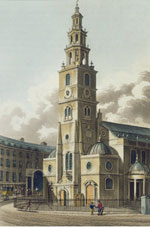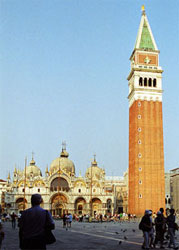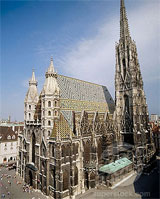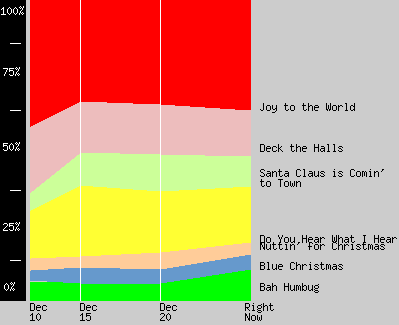2013 Skelly Family Christmas |
 |
|
The Tintinnabulation of the Bells, Bells, Bells, Bells, Etc.
Gaily they ring, while people sing
Songs of good cheer, Christmas is here! Merry, merry, merry, merry Christmas! Merry, merry, merry, merry Christmas! ("Carol of the Bells")
B
ells are a form of purposeful noise. A non-verbal tool people developed to talk to themselves over distance. An invention only slightly less old than the community itself. For centuries bells have been used to express communal alarm, exultation, grief, a call to gather or to pray, or just to tell everybody the time of day.
Kind of funny given that a bell basically makes just one sound, no matter what its motivation. A bit like playing charades with a mime. Over time bells have become not just communication tools but musical instruments and objects of art as well. The bell industry first arose in ancient China—where else?—around 2000 BCE with advancing metallurgy techniques. Chinese rang bells to communicate directly with spirits. In East Asia the fading tone of the bell is still considered spiritually significant.
 The bells of St. Clement Danes Church in London play the nursery rhyme "Oranges and Lemons." (See The Byrds video notes, below.) The church was reputedly established in the 9th century by Danes. The current edifice (completed by Sir Christopher Wren in 1682), was gutted during the Blitz and rebuilt and today serves as the central church of the Royal Air Force.
The bells of St. Clement Danes Church in London play the nursery rhyme "Oranges and Lemons." (See The Byrds video notes, below.) The church was reputedly established in the 9th century by Danes. The current edifice (completed by Sir Christopher Wren in 1682), was gutted during the Blitz and rebuilt and today serves as the central church of the Royal Air Force.
In western culture, the ringing of bells can be traced back to pagan winter celebrations. But in 400 CE the business got what every business needs—an anchor tenant—when Paulinus of Nola introduced church bells into the Christian Church. The process of casting bells is called bellfounding or bellmaking, and in Europe it dates to the 4th or 5th century. The traditional metal is a bronze of about 23% tin, known as bell metal. Other materials sometimes used for large bells include brass and iron. Steel was tried for its economy over bronze, but was found not to be durable. Bells can be made to ring in a variety of ways. The bell can be fixed and the clapper can move, it can be struck on its exterior, or it can be hung so that both the bell and the clapper move back and forth. Carillons are sets of tuned bells numbering at least 23. Carillon art reached a pinnacle in the latter half of the 17th century. Founders in the Netherlands were the first to tune bells with precision. The carillon was introduced to the United States in 1922. The world's two largest, each with 72 bells, were built for the Riverside Church in New York City and for Rockefeller Chapel at the University of Chicago.

The great bourdon bell Emmanuel (1681) in Notre-Dame Cathedral's South Tower weighs 13 tons. It is always rung first. Emmanuel proclaimed Paris's liberation in August 1944. In 2012 the four 19th-century bells in the North Tower were removed to be replaced with a set of 8 new bells cast by the foundry in Normandy that had made the four in 1856. Also, a much larger bell called Marie (6 tons) was cast in the Netherlands and will eventually hang with Emmanuel. The chime below is Marie's.
By the Middle Ages, church bells were common throughout Europe. Just like beer, the Chinese may have been the inventors, but it was the Irish who sold them into a popular fad. Smooth-talking Irish missionaries it was, probably a little drunk. The oldest church bell in the world is one donated by Despot Alexius Slav to the metropolitan church in Melnik, Bulgaria, around 1211-1216. People commonly believed that church bells had the power to protect them from harm. Church bells were rung to ward off thunderstorms, frighten away witches, and halt outbreaks of disease. Now that's some salesmanship, even for Irish missionaries. The Church began to embrace celebrating Christmas late in the fourth century. Just about the same time it began embracing bells. So church bells were associated with the celebration of the Nativity right from the beginning, rung to proclaim the birth of Jesus Christ and call the faithful (however slight their impulse) to come and pray. In times of war bells were melted down to make cannons, but in times of peace cannons were melted down to make bells
Both the Anglican and Catholic churches traditionally followed the rule that the church day starts at sunset. Any service after sundown is considered the first service of the next day. So a service at midnight on Christmas Eve is traditionally considered the first service of Christmas Day. In some churches in the United Kingdom, the largest bell in the tower is rung four times in the hour before midnight and then at midnight all the bells are rung in celebration. In Norway, the Christmas bells begin ringing at 4:30 p.m. on Christmas Eve; and in England, they begin to ring their bells at 11:00 p.m. From the Middle Ages right up to modern times, the Bell industry grew right along with the church building industry. And the church building industry in western civilization has been something to rival the digital age in terms of its continuous evolution and cultural impact. During the 19th century, tuning techniques were forgotten as orders for bells slackened; the bells that were made were generally inferior, and many carillons fell into disrepair. The rediscovery of the tuning process in the 1890s initiated a revival of carillon art. |

The bell making industry today isn’t as large as it once was, and it no longer claims heads of state and Paul Revere as members, but it's still a going business. And some of the leading companies today are the same ones leading the industry hundreds of years ago. Bell founders are long lived.
 Riverside Church in Manhattan is the tallest church in the United States
Riverside Church in Manhattan is the tallest church in the United States (392 ft). It was founded by John D. Rockefeller, Jr, and Harry Emerson Fosdick, a Baptist minister known for his social activism. The tower houses a carillon of 74 bronze bells ranging in weight from the 20-ton Bourdon (the largest and heaviest carillon bell ever cast) to the smallest treble bell weighing 10 lbs. The craft of casting bells has remained essentially the same since the 12th century. Though the process does have some variations, the major differences are in quality control standards. Bells are usually made by casting bell metal of a size appropriate for the pitch the bell is intended to produce. Fine tuning of metal bells is achieved on a lathe where a precise amount of material is removed from the inside of the bell in order to produce a true tone with correct harmonics. Bells are used often to play a chime sequence and so must be well tuned in order to produce a correct scale of musical notes. In carillon tuning, the range of the instrument has been extended in both directions. Nowadays, bellfounders routinely tune very small bells (as small as twenty pounds) and have cast and tuned very large bells (up to twenty tons). Until the beginning of the twentieth century, most carillons were instruments of between twenty-five and thirty-six bells. The average size of modern carillons is about fifty bells, with a number having sixty and even seventy bells. The most important reason for the increased size in carillons has been advances made in tuning bells. Change ringing is the art of ringing a set of tuned bells in a series of mathematical patterns called "changes." It differs from other forms of campanology (such as carillon ringing) in that no attempt is made to produce a conventional melody. Computer software is commonly employed to develop the complex ringing patterns.  The bell tower of St Mark's Basilica in Venice is a campanile, meaning a free-standing sructure. It's 323 ft. tall with five bells tuned in the scale of A. The first St Mark's, begun in 828 after Venetian merchants stole the supposed relics of Mark the Evangelist from Alexandria, was completed in 832. The campanile was also used as a watch tower and lighthouse for the city's dock.
The bell tower of St Mark's Basilica in Venice is a campanile, meaning a free-standing sructure. It's 323 ft. tall with five bells tuned in the scale of A. The first St Mark's, begun in 828 after Venetian merchants stole the supposed relics of Mark the Evangelist from Alexandria, was completed in 832. The campanile was also used as a watch tower and lighthouse for the city's dock.
But however struck, the bell's effect is singular: immutable and enduring, striking a chord within and well as without. A sound that anchors all our days back to the first time we heard it, a constant in our memories accompanying us from earliest youth through old age. Much like Christmas itself. The season has exerted an emotional and spiritual pull on all but the most hardened of men through innumerable generations reaching back to antiquity. Interesting that from the holiday's beginnings, the prime vehicle for announcing Christmas's annual good news is an instrument almost as ancient and almost as mystical.
Keeping time, time, time,
In a sort of Runic rhyme, To the throbbing of the bells- Of the bells, bells, bells- To the sobbing of the bells; Keeping time, time, time, As he knells, knells, knells, In a happy Runic rhyme, To the rolling of the bells- Of the bells, bells, bells: To the tolling of the bells, Of the bells, bells, bells, bells- Bells, bells, bells- To the moaning and the groaning of the bells. From "The Bells," Edgar Allan Poe
 St. Stephen's Cathedral in Vienna stands on the ruins of two earlier churches, the first consecrated in 1147. Major construction and expansion lasted until 1511, and restoration continues to the present. The tower has 23 bells including the second largest swinging bell in Europe, originally cast in 1711 from cannons captured from Muslim invaders. Beethoven discovered he was deaf when he saw birds flying from the church's bell tower and realized he couldn't hear the bells.
St. Stephen's Cathedral in Vienna stands on the ruins of two earlier churches, the first consecrated in 1147. Major construction and expansion lasted until 1511, and restoration continues to the present. The tower has 23 bells including the second largest swinging bell in Europe, originally cast in 1711 from cannons captured from Muslim invaders. Beethoven discovered he was deaf when he saw birds flying from the church's bell tower and realized he couldn't hear the bells.
|
|||||||||||||||||||||
This page features church bells in small audio files. Older Internet Explorer browsers lack the skills to play them. Please open the page with a different browser for your complete Christmas webpage experience. Suggestion: download Google Chrome. It takes less than a minute, and diehard IE users might be pleasantly surprised at the difference. Nothing will blow up.
|
||||||||||||||||||||||

Last Year's Index:
Dec. 10-3.0 Dec. 15-3.28 Dec. 20-3.53 Dec. 25-3.49 This Year: Dec. 10-4.48 Dec. 15-4.13 Dec. 20-4.18 Right now: 4:01 |
The Story Thus Far ...
Current Christmas Spirit breakdown:
12/10/13:
Fully half of visitors appear to be in the tertiary rush stage of some really fine Mexican colitas. What an upbeat crowd! The initial presumption was the YC alum voters were just a bunch of jolly midwesterners, but that was wrong on two counts. The geographic dispersion was broader than expected. And folks are in a really good mood. Are we reading the same newspapers? Don't you people watch Fox? We'll see what happens next week, although with Congress out for Christmas break, what could go wrong?
12/15/13:
Perhaps there's been by now enough waiting on checkout lines or navigating bumper-to-bumper mall traffic or battling undeserved setbacks in lighting the bushes or trimming the tree. The aggregate holiday spirit is recalibrating, now settled back to about 4.1. Still high historically. Is there more in store? The next ten days will tell how well we play through pain. Should peak at the end though. After all, it's going to be Christmas.
12/20/13:
People seem to be in a rut. And rather contentedly so. Have they at long last achieved that inner calm so prized by eastern mystics, just in time for the holidays? Or do they just not have a clue what kind of shape we're really in here? Or have they gotten to where it just doesn't matter? Who cares? Merry Christmas, everybody.
| |||||||||||||||||||||
Go to websitesammy.com homepage
|
The sound of all the bells at Notre Dame Cathedral ringing at the same time. You can achieve a similar effect with the audio clips on this page if you’re into cacophony or just want to replicate the joyous sound of the ending of a war. This video recording was made on Christmas Day 2011, so it features the 19th century North Tower bells that have since been removed. (See inset above.)
|
Pete Seeger created "The Bells of Rhymney" as a protest song in the '50s. He borrowed lyrics from a 1938 poem about a Welsh coal mining disaster ("Gwalia Deserta" by Idris Davies). He put them together with the melody of the English nursery rhyme "Oranges and Lemons." Davies had already borrowed the stanza structure of “Oranges and Lemons” (Say the bells of St. Clements), successive rhyming couplets voiced by bells of various London churches. Davies's poem invoked bells in cities throughout South Wales. The Byrds included "The Bells of Rhymney," adapted to their folk-rock style (and Roger McGuinn's jangly Rickenbacker 12-string), on their debut album, Mr. Tambourine Man (1965).
|
